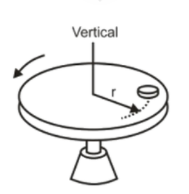A small particle of mass 036g rests on a horizontal turntable at a distance 25cm from the axis of spindle. The turntable is acceleration at rate of α=13rads−2 . The frictional force that the table exerts on the particle 2s after the startup is
40μN
30μN
50μN
60μN
The correct Answer is:C
f=ma=m√a2t+a2r
=m√(Rα)2+(Rω)2
=m√(Rα)2+[R(αt)2]2
=0.36×10−3
⎷(0.25×13)2+[0.25(13×2)2]2
=50×10−6N
=50μN
Topper's Solved these Questions
- CIRCULAR MOTIONBOOK - DC PANDEYCHAPTER - CIRCULAR MOTIONEXERCISE - Level 1 Subjective
13 Videos
- CIRCULAR MOTIONBOOK - DC PANDEYCHAPTER - CIRCULAR MOTIONEXERCISE - Level 2 Single Correct
18 Videos
- CIRCULAR MOTIONBOOK - DC PANDEYCHAPTER - CIRCULAR MOTIONEXERCISE - Assertion And Reason
28 Videos
- CENTRE OF MASS, LINEAR MOMENTUM AND COLLISIONBOOK - DC PANDEYCHAPTER - CENTRE OF MASS, LINEAR MOMENTUM AND COLLISIONEXERCISE - Level 2 Subjective
21 Videos
- COMMUNICATION SYSTEMBOOK - DC PANDEYCHAPTER - COMMUNICATION SYSTEMEXERCISE - Only One Option is Correct
27 Videos
Similar Questions
A penny with a mass m sits on a horizontal turntable at a distance r from the axis of rotation. The turn table accelerates at a rate of αrad/s2 from t=0 The penny starts slipping at t=t1 The friction coefficient on the surface of turn table and the penny is μ find :
(i) The direction in which it starts sliding
(ii) The magnitude of frictional force at time t=t2(t2>t1)
View SolutionA small coin of mass 40 g is placed on the horizontal surface of a rotating disc. The disc starts from rest and is given a constant angular acceleration α=2 rad s−2. The coefficient of static friction between the coin and the disc is μs=3/4 and the coefficient of kinetic friction is μk=0.5. The coin is placed at a distance r=1m from the centre of the disc. The magnitude of hte resultant force on the coin exerted by the disc just before it starts slipping on the disc is :

View Solution
Knowledge Check
A small coin of mass 80g is placed on the horizontal surface of a rotating disc. The disc starts from rest and is given a constant angular acceleration α=2rad/s2. The coefficient of static friction between the coin and the disc is μs=3/4 and cofficient of kinetic friction is μk=0.5. The coin is placed at a distance r=1m from the centre of the disc. The magnitude of the resultant force on the coin exerted by the disc just before it starts slipping on the disc is
 A0.2NB0.3NC0.4ND1N
A0.2NB0.3NC0.4ND1NA rough horizontal plate rotates with angular velocity ω about a fixed verticle axis. A particle or mass m lies on the plate at a distance 5a4 from this axis. The coefficient of friction between the plate and the particle is 13 . The largest value of ω2 for which the oparticle will continue to be at rest on the revolving plate is
Ag3aB4g5aC4g9aD4g15aA body of mass 2 kg at rest on a horizontal table. The coefficient of friction between the body and the table is 0.3 . A force of 5N is applied on the body. The force of friction is
A5NB5.88NC6ND20N
Two particles of masses 1kg and 2kg are placed at a distance of 50cm. Find the initial acceleration of the first particle due to gravitational force.
View SolutionA small coin of mass 5 g is placed at a distance 5 cm from centre on a flat horizontal turn table. The turn table is observed to make 3 revolutions in √10s. The frictional force on the coin is (n×10−3)N. Find value of n.
View SolutionA gridstone has a constant acceleration of 4 rad s−1. Starting from rest, calculate the angular speed of the grindstone 2.5 s later.
View SolutionA gridstone has a constant acceleration of 4rads−1. Starting from rest, calculate the angular speed of the grindstone 2.5 s later.
View SolutionA block of mass 500 g is at rest on a horizontal table. What steady force is required to give the block a velocity of 200cms−1 in 4 s ?
View Solution
